
Horse yards and handling facilities
Series: Agfact A6.7.1 Edition: Second edition Last updated: 18 Feb 2005
Introduction
Well-designed and properly constructed horse-handling facilities can add greatly to the success of horse management. It would be impossible to set down plans and specifications for facilities to handle all breeds and sizes of horses and ponies; however, certain principles apply to all horses, their handling, and the facilities used. The following measurements and specifications apply to horses from about 14 to 17 hands (140 to 170 cm) and can be altered for any situation.
Planning a yard system
Plan a complete yard system even if only part of it can be built at a time. Small holding paddocks near the main yards can be built cheaply and will eliminate overcrowding and congestion in the main yards.
Take advantage of available shade trees, especially around the holding yards. It is an advantage to have a supply of good water in the holding yards.
Working yards
Working yards should be built on a site central to all paddocks and have all-weather access to a roadway. A gently sloping site on firm ground is best. If possible, have the main entrance on the lower side and the working area on the upper side.
Size of yards
It is seldom necessary to yard all your horses at one time, so the use of holding paddocks will greatly reduce the size of the yards required. Yards should not be overcrowded. Handling the horses will be a lot easier if yards are never more than one-third full. The area needed for each horse in a yard that is loosely filled is approximately 7.5 m2 to 9.5 m2. To draft, catch or work horses, reduce the number of horses in the yard.
For a standard panel of fencing, suggested specifications are:
- 2.40 m or 2.75 m panels, centre to centre
- 1.70 m to 1.80 m overall height, including cap-rail
- 230 mm maximum interval between rails.
All rails (except on dividing fences) should be on the inside of posts. The bottom rail can be 380 mm to 460 mm off the ground.
Material
- Posts. Bush timber 230 mm to 310 mm in diameter, 1.07 m in ground. Steel piping 76 mm in diameter is also good. Steel posts should be cemented into the ground to avoid the need for overhead braces.
- Rails. 150 mm × 50 mm hardwood rails, bush timber 150 mm in diameter, or 45 mm steel piping.
- Cap-rails. 76 mm × 76 mm hardwood rails, or 150 mm diameter bush timber, or 45 mm steel piping. Cattle yard mesh with a roll top (reinforced top section) can be used in place of rails if materials have to be bought.
Holding paddocks and wings to main yards
An alternative to post and rail fencing is steel cattle cable. This is particularly useful where heavy stock pressure would make wire fencing dangerous.
Gates
Make entrance gates to yards at least 3.00 m wide, and internal gates 2.40 m wide. Use the same rail spacings as for fence panels. Gates must fit neatly to prevent horses from rubbing at corners and getting their necks caught, which can cause choking.
Round yard
A round yard alone can be used as an exercise or lunging ring, in which case the diameter would be between 12 m and 18 m. If the yard is to be used for breaking in, the diameter should be between 7.6 m and 10.7 m.
|
Figure 1. The wall of a round yard with the appropriate outward slope from bottom to top 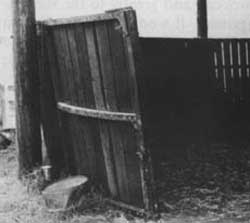
|
Figure 2. The bottom of an outward sloping round yard wall should be about 380 mm from the perpendicular 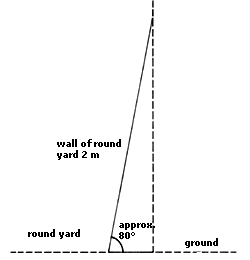
|
Dual-purpose round yard
As the name suggests, a dual-purpose round yard combines some of the qualities of the above yards. Its diameter would be about 9.8 m. A yard this size can be used successfully for breaking in, as a spare exercise yard, for training and educating young foals, and for teaching your horses to lunge (see Plan 3).
The height of the perimeter fence/wall should be 1.80 m to 2.14 m. An outward slope from bottom to top of about 380 mm horizontally is advisable. An outward slope keeps the horse off the wall, preventing injury to itself, and does not allow the horse to wipe the rider along the wall. If the horse makes contact with the wall, it will be with its feet first and not its body.
Figure 3. A dual-purpose round yard with sand floor. The walls are lined with rubber conveyor belting
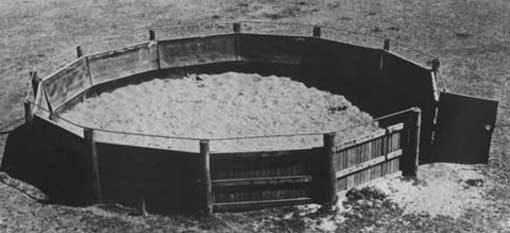
Construction
The wall may be round or octagonal, or it can have as many sides as you wish to conform to a general round shape.
The walls should be fully enclosed to a height of at least 1.07 m to prevent horses from getting their legs caught in any railings. Railings above 1.07 m can be 230 mm apart. Alternatively, the walls may be solid for the full height. Walls may be of wood, and rubber conveyor belting is often used to line them.
Posts should be on the outside of the wall, and a cap-rail is essential.
Make the gate wide enough to give horses plenty of room to pass in and out—a minimum of 2.40 m.
Coarse sand is an ideal base for the floor. Sawdust is another commonly used base, but it can cause problems with dust. It must be kept clean.
Shade can be a great benefit if you are working horses during summer, but if you use a canopy or roof, make it high enough to avoid injuring a rider or a fractious horse. A roof should be not less than 3.70 m in height.
Teasing and serving yards
Teasing and serving techniques are so numerous that the ones used will depend largely on personal preference and experience. The following information will help you to select the most suitable technique for your conditions.
Teasing
Figure 4
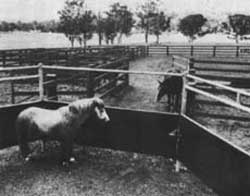
- A teasing rail or fence must be at least 1.07 m high, preferably fully enclosed, with padded top and sides (see Figure 4 at right).
- Make the teasing crush, if used, a maximum 790 mm wide and 2.30 m long, with a 2.75 m head clearance and a padded side rail a minimum 1.07 m high. A mare will suffer severe stress if she is restricted in the crush for extended periods of teasing.
- When using a teaser stallion enclosure (see Figure 5 below), allow the mares free access to the outside of the enclosure, or walk them past the teaser. The enclosure should be about 18 m × 18 m, with fences 1.80 m to 2.14 m high, and rails at most 230 mm apart.
- If a teasing lane runs past the teasing yard, it needs to be at least 9.15 m wide.
Figure 5. A teasing system where a teaser stallion is held in a secure yard in the mare paddock.
Heat is detected by mares ‘showing’ to the teaser stallion.
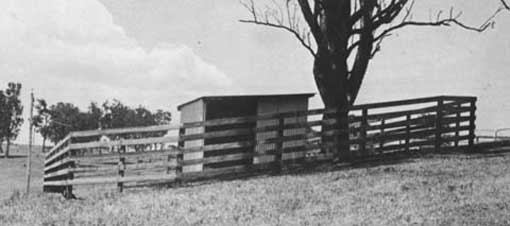
Serving
The less restraint on the mare, the better, having regard for the safety of horses and operator(s). Hygiene is most important, and dust must be kept down. The area required for safe and easy working is about 9.15 m × 9.15 m (80 m2).
There are many teasing and serving methods, but they are too numerous to mention here. It must be remembered that for smaller numbers of mares it is not necessary to hand tease and mate. Equivalent, if not better, results can be achieved by paddock mating.
Stallion yard and stable
The stallion yard should be not less than 0.2 ha (30 m × 30 m), large enough for the stallion to exercise himself. Continual stabling and small yards frequently cause major behaviour problems.
The fences may be of similar dimensions to those of the main working yard—1.80 m high.
An electric wire incorporated as a standoff in the fence is often used to limit rubbing and biting. Precautions must be taken to ensure safety when using electric fencing.
A stallion stable needs to be at least 3.70 m × 3.70 m, with at least 2.75 m ceilings.
Figure 6. A stallion yard off a stable.
Strong mesh is attached to the inside of the rails. Existing trees provide shade.
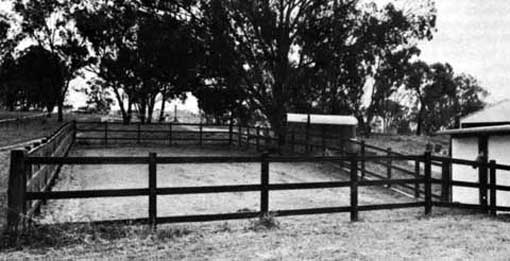
Horse crush
The less restraint the better, so a crush may not be needed. A crush is merely a restraint aid. When dealing with small numbers, the expense and trouble of putting in a crush may not be warranted. Given sufficient time, most practices can be carried out in a small yard with good restraint methods.
Where large numbers of horses are involved and/or time available is limited, a crush can be well worthwhile. Routine management practices can be performed quickly and efficiently, e.g. drenching, vaccinations, follicle and pregnancy testing, castration, branding, and teeth care.
Circumstances will decide the design to be used. For example, you can have a single crush enclosure for small numbers, or a small forcing yard and double crush to accommodate mares and foals. There are a number of proprietary crushes available that allow variations of the above.
The following specifications are basic to any design used:
- Width: Up to 790 mm (inside measurement).
- Length: Up to 2.30 m (per single crush).
- Height: If roof or bars are attached to the top, a minimum clearance of 2.75 m is necessary.
- Rails: Minimum 1.80 m high; 230 mm between rails; bottom rails 380 mm off the ground.
A safer design would incorporate full sides, closed in by either sheet metal (can be noisy) or rubber conveyor belting up to a height of at least 1.07 m.
Both sides of the crush should be able to swing outwards as gates, either as full height gates or split horizontally to form two half-gates. Make one bottom gate at least 1.07 m high. Having the sides in the form of gates ensures quick and easy release of the horse if problems arise.
Figure 7. The back gate of a crush
with the top section hinged to allow
access for rectal examinations.
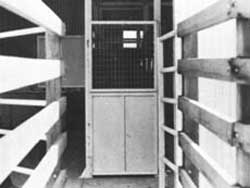
Front and back gates are preferably sliding ones, worked from the near side. You may incorporate half-gates within the sliding gates to allow access to the front and back of the horse, e.g. for drenching, rectal examination, or pregnancy testing.
Make the bottom gate 1.07 m to 1.20 m high. If an in-line double crush is used, the middle sliding gate should not prevent mares and foals from seeing each other.
Material
Gates may be made of wood or steel in similar dimensions as those described for working yards. Steel crushes can be noisy, and sides may need to be lined.
A top crossbar may be needed across the upright supports of the crush to add support.
Loading ramp
A suitable loading ramp is similar to a cattle ramp, with a race 760 mm to 790 mm wide, rails 1.60 m high and a head clearance of at least 2.75 m. The ramp needs to be 4.60 m long. It rises from ground level to a height of 1.15 m. A tailboard is fitted on the outlet to bridge the gap between ramp and truck. The ramp can run off an extension of the race or from its own separate forcing yard.
Widening the ramp to make it another 1.80 m to 2.40 m wide will allow an easier and not so cramped position for unloading. For example, horses can be unloaded without the restriction of a race.
Figure 8. A three-in-one loading ramp, incorporating loading race, unloading ramp and enclosed area for loading and unloading floats at ground level.
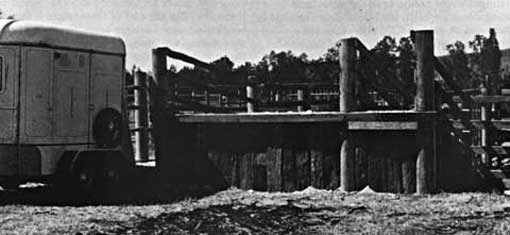
Stables
The following specifications are given only as a guide to the construction of a horse stable or stable complex. There are obviously going to be specific instances and requirements for which these specifications need to be altered, e.g. the great variation in horse sizes.
The following applies to stables in which horses may be required to spend a great deal of time. In instances where horses are not continually stabled, or the stable is used more as a loose box for feeding, grooming etc., then the minimum dimensions mentioned here could be reduced. Under any situation a solid construction is needed to contain horses.
There are prefabricated horse stables available which are competitively priced and may suit either as loose boxes or stables.
Stable walls should be at least 2.75 m high, and 330 to 450 mm (1½ to 2 bricks) thick. If concrete blocks are used, they will need cement filling or steel bars in the centre cavities for extra strength. Damp-proof the walls with a horizontal waterproof course of heavy plastic, asphalt or a layer of vitrified brick a little above ground level. A double-brick cavity construction should be used for the outside walls. Inside walls may be smoothly lined with wooden planking or rubber conveyor belting up to a height of 1.40 m. Lined walls prevent injury and also protect the walls from pawing and kicking.
Figure 9. A stable complex with good-sized sliding doors and adequate ventilation.
The floor is cement, walls are concrete blocks up to 1.00 m, and the railed area is steel.
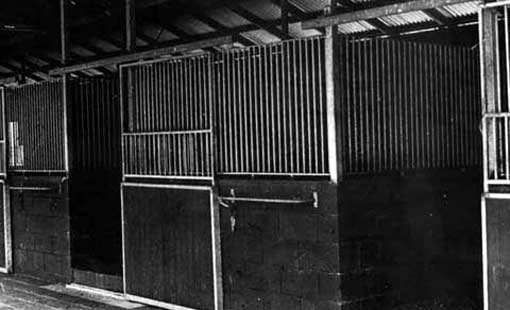
Roof
The roof must provide adequate shelter from the elements. In hot climates insulation is warranted. Guttering should take all run-off water away from the walls. Plenty of ventilation should be provided to let heated, foul air escape.
Doors
Doors should be at least 2.40 m high, and 1.20 m to 1.40 m wide, with no protrusions that might cause injury to horses.
Hinged doors always open outwards, and sliding doors are often used. Half-doors also are often used. A steel bar 230 mm above the bottom door will prevent chewing of the wood. Have the bottom door at least 1.40 m high. A full door with the top half meshed-in can be quite satisfactory.
Latches should be strong and easily turned, with large, flush handles which have no projections that might injure horses.
Water
Free access to clean water at all times is essential. The trough may be built into one corner, 1.07 m off the ground.
Feeder
The feeder may occupy another corner. All sharp edges must be smoothed and rounded. The rim of the feeder should be sufficiently broad to prevent it from being seized by the teeth, as this encourages crib-biting.
Feeders on the ground are often preferred to allow for horses’ normal feeding posture. However, it can be difficult to maintain cleanliness with ground feeders.
Ventilation
The purpose of ventilation is to change the air often enough to keep it fresh without allowing drafts. Fresh air is essential to general wellbeing and resistance to disease. Half-doors or wire mesh doors alone do not provide sufficient ventilation. Some form of window or air passage between the roof and walls is needed for cross-ventilation.
Windows may be wire mesh or louvre. Louvres should direct air upwards inside. In a stable with dimensions 3.70 m × 3.70 m, a window 0.9 m2 is sufficient.
Floor
Common materials used are concrete, rolled sand, dirt and gravel. Floors must be firm and easily cleaned, and be free from low spots in which urine would lie. Horses stabled for extended periods on concrete floors may suffer feet and leg problems. Daily provision of clean, fresh bedding, such as straw or sawdust, is needed.
A slight slope of 15 mm in 3 m will give good inside drainage. Drainage outside the stable must also be adequate.
Paddock fences
Any wire fences, whether barbed or plain wire, can cause severe injury to horses. Post-and-rail fences, or even cattle steel-cable fences as described earlier for smaller paddocks, would be preferable. But the cost of these fences is the restrictive factor for large areas. Some form of wire fencing will probably be necessary to keep the capital cost down. An example of the specifications for a useful horse fence is as follows:
- 1.40 m high
- 5-wire (plain, 2.75 mm or 11-gauge high tensile)
- strainers every kilometre (depending on type of country)
- 50 mm galvanised pipe or treated post every 30 m
- wooden droppers every 3 m.
Electric fences will contain horses. They are being used extensively on properties with both cattle and horses because of their lower cost. However, electric fences should not be used in confined areas such as laneways, working yards or small holding yards. Because of their light construction, electric fences are poorly visible to horses. Therefore, some sort of sight barrier must be used, e.g. more droppers, or painted tin attached to the wire.
Horse yard plans
Plan 1 Large set of yards for 60 to 80 horses
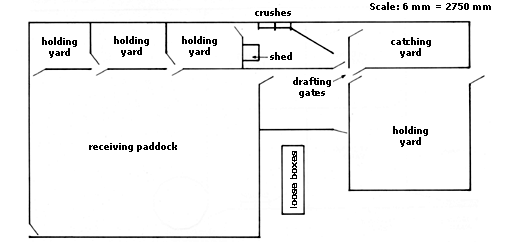
Plan 2 Alternative plan for a large set of yards for 60 to 80 horses (incorporates a teaser yard)
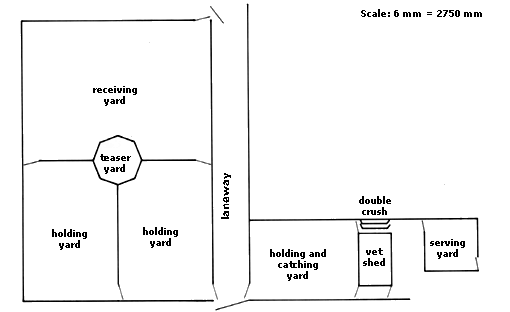
Plan 3 Smaller set of yards for 20 to 30 horses (incorporates a round yard)
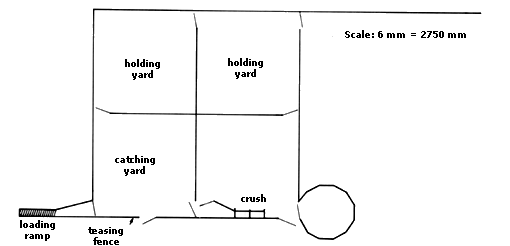
Author: Bill McKiernan

